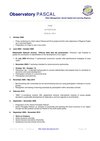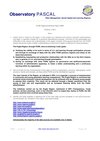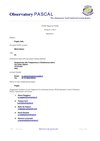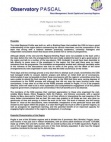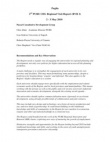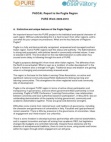Puglia Region, Itlay
Apulia or Puglia (from Greek Ἀπουλία, in Italian: Puglia, pronounced [ˈpuʎʎa]) is a region in Southern Italy bordering the Adriatic Sea in the east, the Ionian Sea to the southeast, and the Strait of Òtranto and Gulf of Taranto in the south. Its most southern portion, known as Salento peninsula, forms a high heel on the "boot" of Italy. The region comprises 19,345 km² (7,469 square miles), and its population is about 4.1 million. It is bordered by the other Italian regions of Molise to the north, Campania to the west, and Basilicata to the southwest. It neighbors Greece and Albania, across the Ionian and Adriatic Seas, respectively. The region extends as far north as Monte Gargano, and was the scene of the last stages in the Second Punic War.
Situated at the south-eastern tip of the Italian peninsula, Apulia covers over 19,000 km2 in succession of broad plains and low-lying hills. The only mountainous areas, the Gargano promontory and the Monti Dauni, do not exceed 1,150 m and are to be found in the north of Apulia, which is the least mountainous region in Italy.
Apulia is a very dry region. Its few rivers are torrential and are to be found on the Tavoliere delle Puglie, a tableland at the foot of the Gargano promontory that is one of the largest and agriculturally most productive plains in Italy. Elsewhere, rainwater permeates the limestone bedrock to form underground watercourses that resurface near the coast. Groundwater is therefore abundant, and there are many caves and potholes. The caves at Castellana Grotte are particularly spectacular.
The region's contribution to Italy's gross value added was around 4.6% in 2000, while its population was 7% of the total. The per capita GDP is low compared to the national average and represents about 68.1% of the EU average.[3]
In comparison with the country as a whole, the economy of Apulia is characterised by a greater emphasis on agriculture and services and a smaller part played by industry. The share of gross value added generated by the agricultural and services sectors in the total gross value added of the region is above the national average in 2000, whereas the share of industry is below.
In the last 20 years the industrial base of the region's economy has changed radically. Alongside highly capital-intensive large-scale plants - such as ILVA (steel-making) in Taranto and Eni (petrochemicals) in Brindisi and Manfredonia - a network of small and medium-sized firms has gradually expanded, and these now provide approximately 70% of the jobs in the region. The majority of such firms are financed by local capital. As a result, highly specialised areas have developed, producing on a scale not only of domestic but also of international significance: food processing and vehicles in the province of Foggia; footwear, textiles, wood and furniture in the Barletta area north of Bari; wood and furniture in the Murge area to the west; engineering, rubber, wood and furniture and computer software around Bari itself; textiles and clothing at Monopoli-Putignano to the south; and footwear and textiles in the Casarano area. In certain of these sectors - especially textiles, clothing, footwear, vehicles and food products - the region has attained a significant degree of competitiveness with foreign producers. A major contribution to the competitiveness of the region's economy stems from the existence of important research and development centres such as Tecnopolis-CSATA near Bari, the Cittadella della ricerca (Centre for research and new materials) near Brindisi and the new software development centres, again near Bari.
The region has a good network of roads but the railway network is somewhat inadequate, particularly in the south. Apulia's 800 km of coastline is studded with ports, which make this region an important terminal for transport and tourism to Greece and the eastern Mediterranean.
The population density in Apulia is just above the national average. In 2008 it was equal to 211 inhabitants per km2. Foggia is by far the least densely populated province (96 inhabitants per km2 in 2008), whereas Bari is the most densely populated province (308 inhabitants per km2 in 2008).
Emigration from the region's depressed areas to northern Italy and the rest of Europe was very intense in the years between 1956 and 1971. Subsequently the trend declined as economic conditions improved, to the point where there was net immigration in the years between 1982 and 1985. Since 1986 the stagnation in employment has led to a new inversion of the trend, caused not so much by an increase in the number of people leaving but by a fall in the number coming to live in the region, but in the 2000s net immigration has been positive again. As of 2008, the Italian national institute of statistics ISTAT estimated that 63,868 foreign-born immigrants live in Apulia, equal to 1.6% of the total regional population.
Source: Wikipedia
 Printer-friendly version
Printer-friendly version- 459 reads

